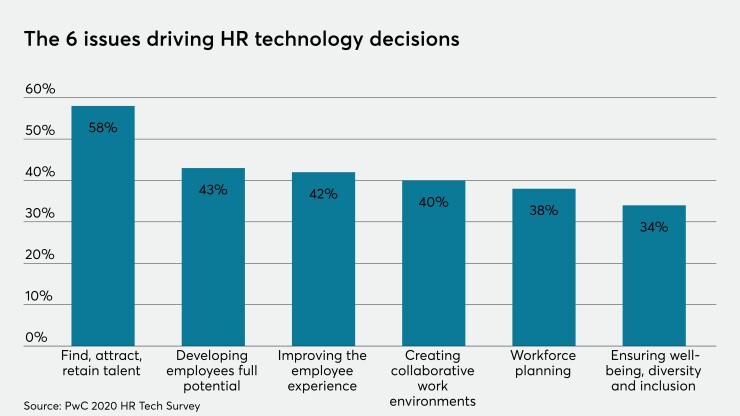Next-gen HR software changes how companies connect with and manage talent, which can impact how diversity and inclusion is integrated into the hiring process.
Hoping to tap into these benefits, organizations are planning to increase their investments in HR tech through 2022, according to a PwC global survey of 600 HR and HR information technology leaders. Attracting new talent, developing employees’ peak potential and improving the work experience through automation are the top goals for employees implementing new technologies, according to PwC.
“Employers are looking to invest in the strategic side of HR,” says Dan Staley, HR technology leader with PwC. “Fifty-six percent of those surveyed say they are going to increase investments in finding, attracting and retaining talent.”
A decade ago, HR tech was lagging in adapting to new technologies, but today, HR cloud solutions are a $148 million market. About 74% of companies surveyed by PwC are planning to increase their spending in HR tech this year in order to address their main talent needs. Employers are expected to make investments in talent acquisition (49%), improved user experience for employees (48%) and skills mapping and career path tools (46%).
“Technology in the HR space is used by every employee, which makes it a little bit different than other domains” Staley says. “In terms of the employee experience and developing talent, it really comes down to giving and getting feedback.”
Diversity and inclusion is one area where improvements in HR tech can benefit employee recruitment and retention to make sure the organization isn’t being biased during the hiring process, Staley says.
“The recruiting tools that are out there today are designed to remove the bias in interviewing,” he says. “Employers can have AI involved in video-based interviewing, which takes into account how candidates answer the questions and render a score of what the fit is, in an effort to take out any human bias.”
Additionally, for internal promotions, having a platform where employees can update their skills and goals, keeping them current, will give managers a better idea of where to go when it comes to promoting from within the organization or making other structural and talent changes.
But getting employees to use these tools can be a challenge:about 82% of those surveyed say they struggle with adoption challenges, and lack of preparation, not meeting user needs, unclear user benefits, and poor user experiences are some of the reasons survey respondents believe these technologies aren’t embraced.
While traditional training methods are not enough to improve adoption rates, incentives and gamification can be effective tools, according to PwC. Indeed, these two techniques were rated the most effective methods to combat low adoption.
“Understand the business problem you’re trying to solve with the technology and that you’re talking to line managers and employees to make sure you are solving a real problem when you roll the tech out. That will help with the adoption and the disconnect,” Staley says.






